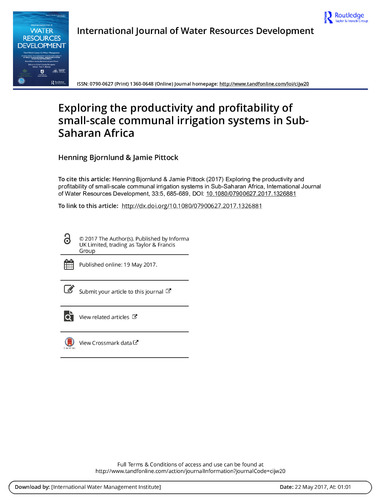Exploring the productivity and profitability of small-scale communal irrigation systems in Sub-Saharan Africa
Abstract
This special issue explores the challenges associated with increasing the productivity and profitability of small-scale communal irrigation systems in a world with growing demand for food and scarce water supplies. Case studies from Mozambique, Tanzania and Zimbabwe in south-eastern Africa are used to detail the challenges, opportunities and possible solutions.
At six irrigation schemes, two in each country, the project provided simple tools to farmers to enable them to measure soil water and fertility to develop their own, more efficient agronomic practices (Stirzaker, Mbakwe, & Mziray, 2017). The project also facilitated Agricultural Innovation Platforms for discussion among stakeholders, to identify barriers and opportunities, and to develop solutions for more profitable farming (van Rooyen, Ramshaw, Moyo, Stirzaker, & Bjornlund, 2017).
The articles in this special issue focus on initial research findings from the project Increasing Irrigation Water Productivity in Mozambique, Tanzania and Zimbabwe through On-Farm Monitoring, Adaptive Management and Agricultural Innovation Platforms. The project was primarily supported by AUD 3.2 million in 2013–17 from the Australian Centre for International Agricultural Research (Project FSC/2013/006) to identify means of improving the environmental and socio-economic sustainability of smallholder irrigation communities. The project is a partnership of eight African and Australian research and governmental organizations led by the Australian National University and including the Commonwealth Scientific and Industrial Research Organisation (Australia), University of South Australia, National Institute for Irrigation (Mozambique), Ardhi University (Tanzania), International Crop Research Institute for the Semi-Arid Tropics (Zimbabwe), University of Pretoria and the Food, Agriculture, Natural Resources and Policy Analysis Network. Particularly in Africa, great reliance has been placed on irrigation to meet food security. Significant investments were made in irrigation infrastructure in the 1970s and 1980s. However, these schemes have had limited success and largely resulted in decaying infrastructure, financial failures, low productivity and low utilization of land (Mutiro & Lautze, 2015; Stirzaker & Pittock, 2014). Most attempts to overcome these issues have focused on hard solutions, that is infrastructural refurbishment or rejuvenation (Inocencio et al., 2007).

